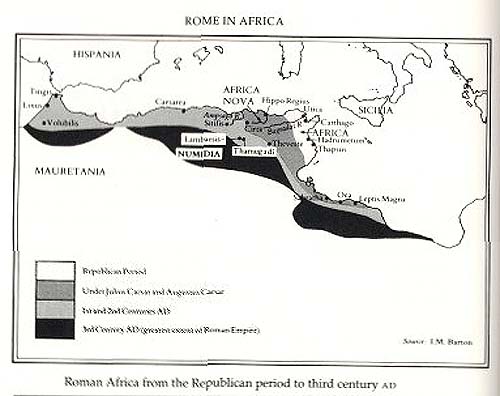

A. Outline:
I. Introduction
A. Carthage: Garden of Delights, Most Splendid of Cities
B. The Periphery Becomes Center
II. Africa as Periphery
A. Africa Imagined Geographically
B. Africa Imagined Metaphorically-- 2 Competing Visions
1. Structured City, Unstructured countryside
2. Decaying City, Rejuvenating Garden
The Cult of Isis: Snowden figures 60 & 61
III. Africa as Center
A. Why Context Matters: Africa as New Center
B. Africa the Urban Garden: African Abundance & Spectacles
1. Common Tropes: Xenia and Banquets, Spectacles, Eternal Time & Cyclical Time, Dionysus, the Sea, Venus, Life of the Great Estates, the Muses, Myths and Decorations
2. North African Mosaics from Late Antiquity: Snowden figures 26, 51-54, 56
B. Terms:
Africa: On the Roman territorial and administrative map, Africa was a fluid concept. In a strict sense, the term was used to designate the ancient province conquered by Rome in the year 146 BC at the end of the Third Punic War. This Africa, called Africa Vetus ("Old Africa"), did not extend beyond about 25,000 square kilometers, that is, about 9,653 square miles, corresponding to the ancient territory of Carthage....at the northeastern corner of modern Tunisia, plus a thin band of coast extending form the modern Gulf of Tunis to the Gulf of Gabès.....In 46 BC Julius Caesar, after his victorious campaign against the partisans of Pompey and their ally, the Numbidian king Juba I, annexed the territory of the latter and formed another province, called Africa Nova ("New Africa"). At the beginning of the reign of Augustus (ruled 27 BC-AD 14), these two provinces were combined into one and renamed Africa Proconsolaris. (Blanchard-Lemée 22-23)
Cardo: A normal city, in the eyes of the Romans, was laid out in a square or a rectangle crossed by two perpendicular roads which met the middles of the four outside lines. One of these two roads axes was oriented from north to south. It was called the cardo (which means pivot or door hinge, because it followed the ideal line on which the sky seemed to swing). The east -west axis was the decamanis. (Woloch 10-11)
Late Antiquity: 200-700 AD) is characterized by the acceptance of Christianity as state religion, increasing border troubles in west and east, and the grand solution of dividing the empire into two halves (Nigel Nicholson's Hum110 Timeline).
Xenia (Greek for "hospitality): "the generic name given to the numerous still-life representations consisting of fruits, vegetables, game, and other victuals found on the mosaic floors of dining rooms or reception rooms; they were included to honor the guests and to emphasize the generosity of the master of the house." (Blanchard-Lemée 65) See Snowden figure 56.
Sodalite: an organized society or fellowship; "the great popularity of...amphitheater hunting events had inspired the formation of a number of corporations that both maintained the wild animals and hired animal killers to carry on the games. These sodalites, which were specific to Roman Africa, were known by various names: the Telegenii, Leontii, Pentasii, Sinemattii, Crescentii, Taurisci, and so forth. They were distinguished from one another by various emblems, symbols, and numbers. In addition to participating in the organization of spectacles of this kind, they also had the function of funerary societies; they were also active in the production and export of olive oil." (Blanchard-Lemée 214)
See Snowden figure 26. From right to left the picture reads:
Telegenii (staff w. crescent) "We three are getting along fine"
Leontii (stalk of mullet) "Let us amuse ourselves"
Pentasii (five pointed crown) "Enough said"
Sinematoii (three pointed crown) "We have come to drink"
Tauriscus (ivy leaves) proposes companions should disrobe
Servant w. wine "Silence! Let the bulls sleep!" (Blanchard-Lemée 214)
C. Timeline:
c. 1000 BC Phoenicians found ports in North Africa
c. 814 BC Traditional date of the foundation of Carthage by Dido the Phoenician
509 BC Foundation of Roman Republic: first Roman-Carthage Trade Agreement
149-146 BC Third Punic War: destruction of Carthage by Scipio. Africa Proconsularis founded
46 BC Caesar conquers rivals. Roman territory is expanded to include Africa Nova
36 BC Augustus becomes the uncontested master of Africa; the romanization of Africa begins.
AD Mid 1st C Beginning of prosperity for Roman Africa
AD 170 Apuleius writes The Golden Ass
AD 180 First known Christian martyrs of Africa executed
AD 193 Septimus Severus becomes the first African Emperor
AD 203 Martyrdom of St. Perpetua and her companions at Carthage
AD 311 Constantine becomes emperor
AD 397 St. Augustine writes his Confessions
AD 410 Sack of Rome by Visigoths; Rome renounces Britain
AD 429-39 Invasion of Africa by Vandals; Vandals seize Carthage
D. Selected Bibliography:
Blanchard-Lemée, Michèle, et. al. Mosaics of Roman Africa. NY: George Braziller, 1995.
Raven, Susan. Rome in Africa, 3rd ed. NY: Routledge, 1993.
Rich, John, ed. The City in Late Antiquity. NY: Routledge, 1992.
Thébert, Yvon, "Private Life and Domestic Architecture in Roman Africa," A History of Private Life, ed. Paul Veyne. Cambridge, MA: Harvard UP, 1987.
Witt, R.E. Isis in the Greco-Roman World. Ithaca, BY: Cornell UP, 1971.
Woloch, G. Michael. Roman Cities. Madison: U of Wisconsin P, 1983.